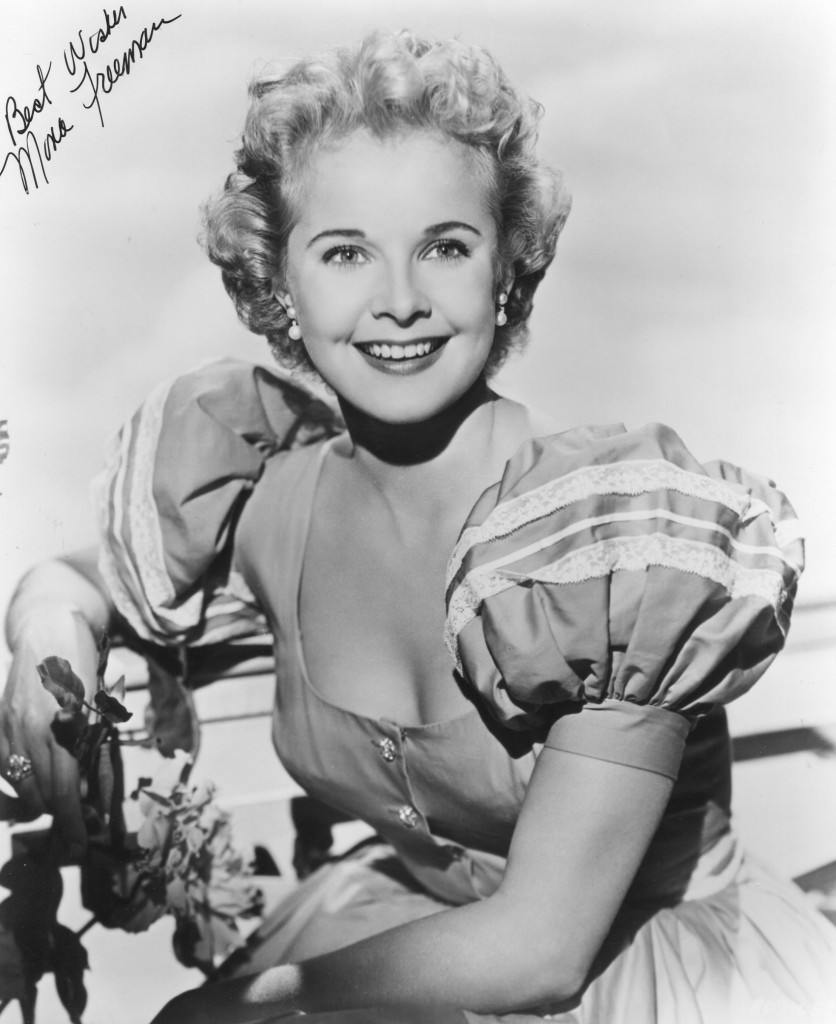
Pert and pretty Mona Freeman was born in 1926 in Baltimore. Her first major film role was in “Junior Miss” in 1945. Other roles include “Dear Ruth”, “Mother Wore Tights”, “The Heiress” and “Battle Cry”. She died in 2014.
Her “Independent” obituary by Tom Vallance:
Her first screen role was to be as Barbara Stanwyck’s stepdaughter in Billy Wilder’s classic, Double Indemnity (1944), but she photographed too young so was replaced by Jean Heather. Her screen debut was in an uncredited role in National Velvet (1944), then she played a 15-year-old in wartime France in Till We Meet Again (1944), but her first major role was in Robert Florey’s compelling Danger Signal (1945), in which she is deceived by the charms of fortune hunting Zachary Scott and refuses to heed the warning of her older sister (Faye Emerson).
In the 1940s the escapades of teenage heroines were a popular staple of Broadway plays, and Freeman was cast in two delightful screen adaptations, Junior Miss (1945) and Dear Ruth. Peggy Ann Garner had the star role in Junior Miss, but Freeman was amusingly effective as her older sister, embarrassed at Garner’s over-dramatising, and constantly being called on by young suitors. In Dear Ruth she had a central role as a teenager who corresponds with a soldier using the name and photograph of her glamorous older sister (Joan Caulfield), sparking a chain of misunderstandings when the soldier (William Holden) comes to call when on leave.
The film’s success spawned two sequels, Dear Wife and Dear Brat , with Freeman getting top billing in the last and still looking the part, though actually 25 years old. In 1945 she married a millionaire car dealer, Pat Nerney, and while she was filming Mother Wore Tights she discovered that she was pregnant with her only child, Mona Jr, known as “Monie”.
In the Grable musical she had a good role as the oldest daughter of vaudeville performers who misguidedly becomes ashamed of her parents. The film was a big hit, and Grable’s favourite of her films.
One of Freeman’s favourite roles was that of Olivia DeHavilland’s cousin Marion in William Wyler’s masterly The Heiress (1949). Though she was leading lady to William Holden in Streets of Laredo (1949) and Alan Ladd in Branded (1950), Freeman was not happy that her teenage image persisted. “Just like driving the same road day after day, they’ve become a bore to me,” she said, and stated that she wanted to play “wildcats, brazen women, the menacing side of the triangle.”
After she divorced Nerney in 1952 her name was linked with Vic Damone, Frank Sinatra and Bing Crosby. She and Crosby were expected to wed after his wife, Dixie Lee, died, but they were Catholics and Freeman had been divorced. She married businessman H Jack Ellis in 1961. He adopted Monie, and the marriage lasted until his death in 1992 (Mona and her daughter can be glimpsed as part of the circus audience in The Greatest Show on Earth, 1952).
Her last notable screen role was that of the sweetheart of an ambulance driver (Robert Mitchum) who has become fatally seduced by a pathological beauty (Jean Simmons) in Angel Face. One of the best scenes is the first meeting between the two women, Simmons having suggested they have lunch. The cat-and-mouse sparring that follows is superbly played by both actresses.
Freeman made her last film, Dragoon Wells Massacre, in 1957, and the following year she toured opposite Edward G Robinson in Paddy Chayevsky’s play Middle of the Night. She was a regular guest star in television series until the mid-1960s – she played in three episodes of Perry Mason as three separate clients. She then concentrated on her successful career as a portrait painter, owning an art gallery and having an art studio in her home. “I didn’t dislike acting,” she said, “but when I no longer needed the money I lost all interest.

